Soccer Lights For Bedroom
The choice of the right soccer field lighting system requires a thoughtful process. Whether it is a new installation or replacement, so many factors arise. So, here is a complete reference for the expert and the layman, with no time wasting.
In this ultimate guide, you will find the answer to the most all-compassing questions. From the tech data to the many explanations in simple language, we have covered it all.
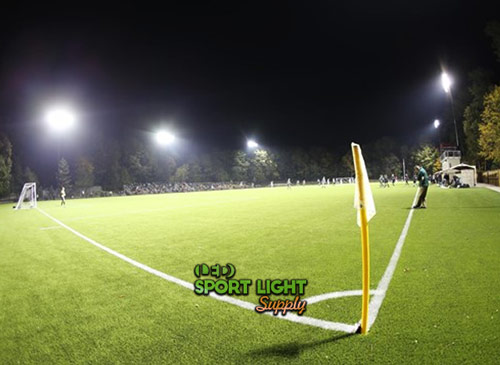 For the most part, you will learn about the perfect soccer field lighting layout. That is, the most suitable for any stadium or practice pitch. But you can apply this info to any standard high school athletic field. It does not even matter if you have a professional or amateur football club. With this knowledge, you will find out more cost-competitive tools and ideas. Plus, you will understand the essential key points to make savvy purchases. Or write a killer contract.
For the most part, you will learn about the perfect soccer field lighting layout. That is, the most suitable for any stadium or practice pitch. But you can apply this info to any standard high school athletic field. It does not even matter if you have a professional or amateur football club. With this knowledge, you will find out more cost-competitive tools and ideas. Plus, you will understand the essential key points to make savvy purchases. Or write a killer contract.
Starting with the very basics, we will see what we mean by soccer field lights and layout. Some details about standard practices and regulations will come up next. In the section on retrofitting, you will read about how to upgrade your light fixtures. A buyer's guide will also help you in the right selection of LED products for your soccer activities. Lastly, we will discuss prices and FAQs to give you any missing detail.
Table of Contents
- What kind of lights do soccer field and football stadium use?
- 1. High mast lighting
- 2. High power flood lights
- 3. Spot lights
- 4. RGB flood lights
- Soccer field lighting layout
- 1. Number of soccer field light poles
- 2. Light pole height in a soccer stadium
- 3. Lighting pole position
- 4. Distance between the light pole and soccer field sidelines
- 5. Soccer stadium ceiling height
- Soccer field lighting design, standard and regulations
- 1. IES soccer field lighting lux & footcandle (brightness) levels requirement
- 2. Lighting uniformity standard for a soccer stadium
- 3. Color temperature
- 4. Flicker-free
- 5. CRI and TLCI
- 6. Glare
- 7. Pitch illuminance switch mode
- 8. Shadowless illumination regulations
- 9. Maintenance factor
- Soccer field lighting replacement and retrofit guide
- 1. Why do we need to replace or retrofit metal halide, halogen, HPS with LED lights?
- 2. How to replace metal halide soccer field lights
- 3. How to replace halogen soccer stadium lighting
- 4. How to retrofit HPS soccer pitch lighting
- Common mistakes when retrofitting the soccer field & stadium lighting
- How to select the best soccer field lights? A buyer's guide
- 1. Type of lighting
- 2. Energy efficiency
- 3. Soccer field lighting wattage
- 4. Life span
- 5. Color temperature
- 6. Beam angle
- 7. Anti-glare feature
- 8. Lighting for Mobile light tower or conventional light pole?
- 9. Lighting control system
- 10. Weight of lighting fixtures
- 11. Installation accessories
- 12. Warranty
- Average soccer field light cost
- 1. The cost of buying the soccer field lights
- 2. The cost of installing the stadium lights
- Soccer pitch lighting Q&A
- 1. What wattage are stadium lights?
- 2. What are stadium lights called?
- 3. How to turn on soccer field lights?
- 4. Why do stadium lights take long to turn on (for metal halide)?
- 5. How much does it cost to put lights on a soccer field?
- 6. Symmetric vs asymmetrical soccer stadium lighting – what are they?
- 7. Where was the first floodlit soccer match played?
- Conclusion
What kind of lights do soccer field and football stadium use?
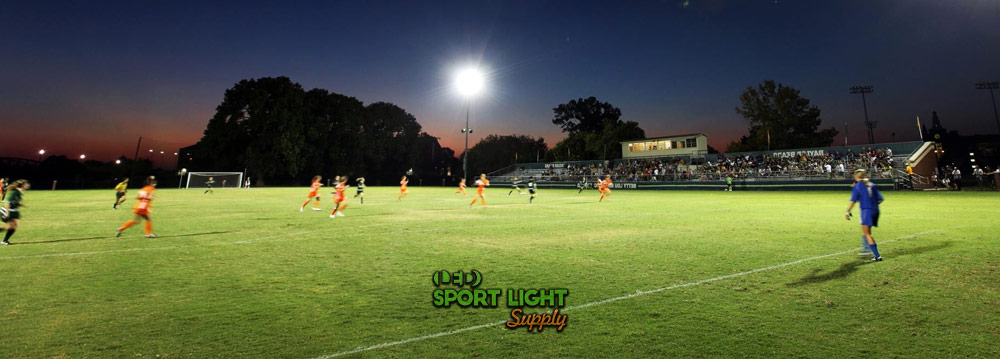
You can find varying lighting solutions in different sports venues. For example, a field house might host several sports events. So, it may need suitable lighting equipment for each tournament and competition. On the contrary, a domed stadium has multiple lighting circuits. And they came with the original design.
On a soccer field, you can find a mix of portable lights used in the athletic field and standard football light fixtures. In other words, the ones you would expect to see in a stadium. For instance, light fixtures on high light poles and spotlights.
With time and an increase in popularity, soccer attracted more and more audiences in the stands. So, two basic problems arose. The first issue concerns the power consumption. In fact, more people equal more sports lights. As we will see, the second one involves rules and technical requirements.
Here are the main types of lighting you can find in a soccer arena.
1. High mast lighting
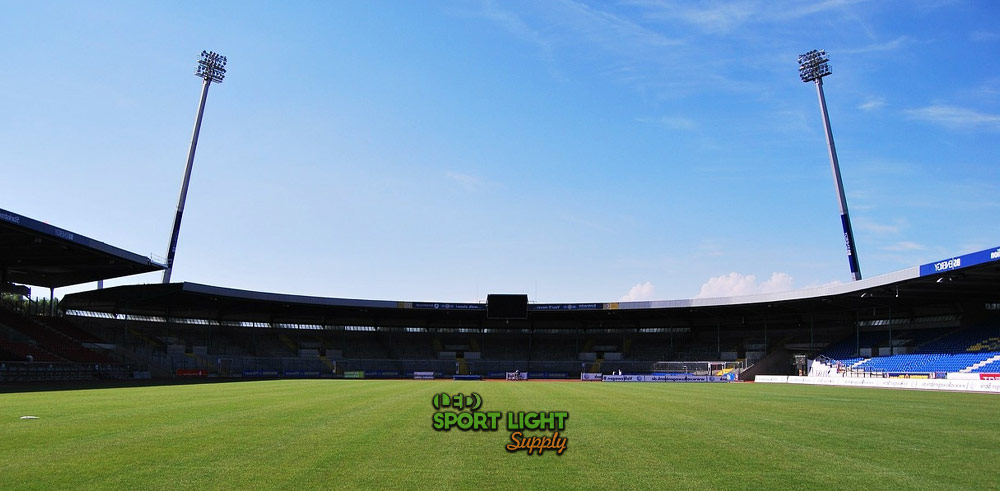
High mast lighting is the iconic set of floodlights in any famous stadium. Think of the illumination from above that lights a soccer event. In detail, it is made of lighting fixtures designed for high mast poles (20 to 50 meters).
The application of high mast floodlights in a stadium follows a standard design. Basically, a lighting layout decides where to place every light pole.
Portable lighting solutions that share the same aesthetics are known as light towers. In short, a single unit is a monopole structure made of galvanized steel or other metal.
A lot of nuts and bolts hold the lamp shells, heat dissipators, and accessories. Plus, an electronic control panel and/or batteries, according to the model.
Depending on the model year, several details may vary. But overall, the structure remains the same.
The outdoor high mast flood lights are waterproof. Also, the poles come with wind resistance to withstand the most severe weather conditions. Like indoor light towers, most are dustproof and have several gasket seals to ensure isolation and longevity.
2. High power flood lights
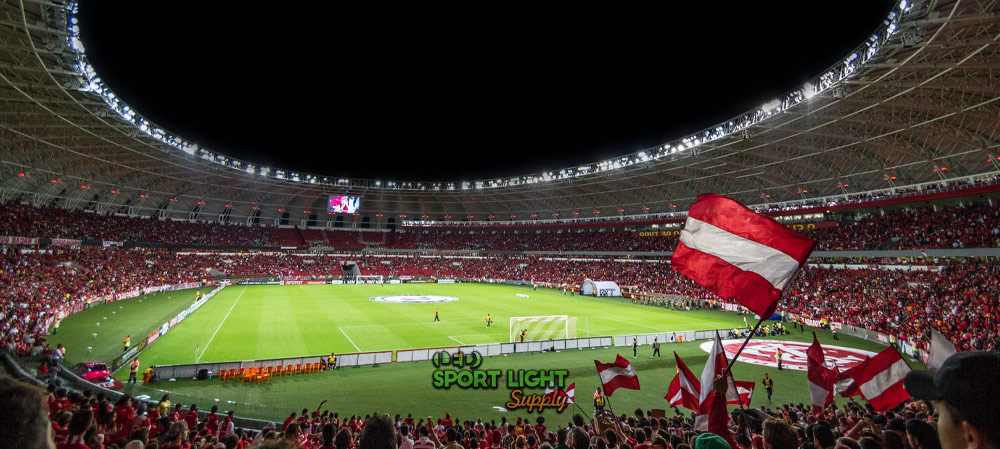
Most sports stadiums need efficient lights to illuminate the wide area of the pitch. Besides, not every soccer field has the same size. So, a general lighting solution must provide enough light all over the athletic field.
High power flood lights provide the brightness necessary for close range. That is, a large beam angle (>45 degrees), which gives a broad illumination. High power means up to 1000 to 3000 watts per LED lamp.
The latest floodlight tech uses LED lamps. Inside, groups of light-emitting diodes generate photons by exploiting some semiconductor materials. The main benefits of using LED flood lights include a longer life span and lower electric bills.
Recently, solar LED stadium lights made it on the market. These models use solar panels to recharge a battery. Nonetheless, they still work like standard flood lights connected to the power grid. As this tech improves, expect to see newer football lighting solutions coming up.
The convenience of using high power flood lights lies in the adjustable positioning. Often, different modules enable custom settings and adjustments to find the right angle and position.
3. Spot lights
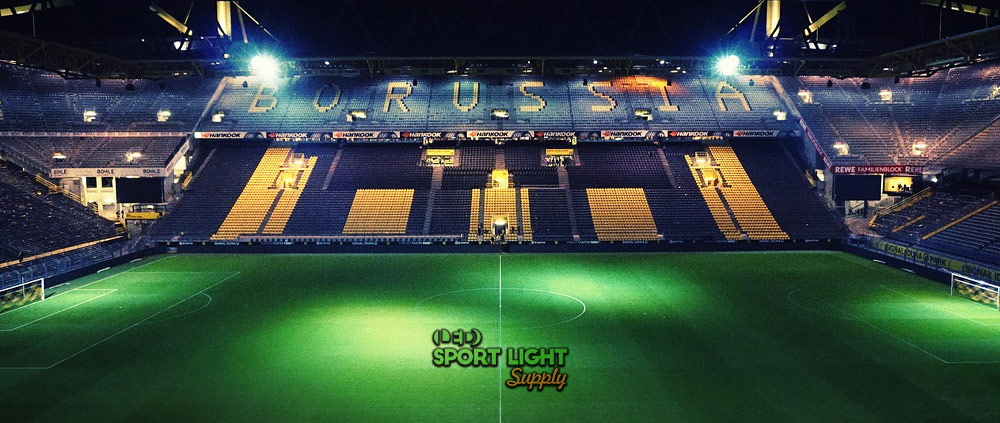
A penalty kick can determine the final score of a whole league season. So, no stadium can do without spot lights during those crucial moments.
As a spectator, your focus is on the ball. Your ears are waiting for the referee's whistle to blow. But if you look closer, often, no shadow is anywhere to be found. That is what spot lights are for.
A spot light is a lighting solution for the long range. In detail, a spotlight has a smaller beam angle (<15 degrees). This feature allows it to create a luminous path or focus on a single spot.
The advantages of LED spot lights are numerous. For one thing, they light up immediately and produce low heat emission. Then again, they are ideal for indoor and outdoor use. Ease of installation and transport are also notable perks.
Most lighting layout involves the use of at least two spot lights that cross over the subject on both sides. But a World Cup stadium usually uses more.
4. RGB flood lights
The more prestigious the venue, the more alluring the props. Soccer is but another form of entertainment. So, a world-renown stadium must offer more than regular lighting.
Multicolor RGB LED flood lights let you choose any color. Plus, they offer different plays of light, all controllable via remote control. Or a more traditional control room.
Traditional LEDs can emit only one type of light, usually white. Instead, RGB LEDs are nothing more than three types of LEDs mounted on the same piece. That is, red, green, and blue LED diodes. These colors are also what the acronym RGB stands for. Additionally, you can find RGBW LED flood lights. In addition to having the three basic colors, they include white (the letter W stands for white).
During the break, decorative lights are vital. For instance, for a performance, you can transform the soccer field into a stage. These light fixtures are also useful to create a mesmerizing light show. Above all, they increase the value of the stadium. In other words, they provide a more memorable experience for visitors.
Soccer field lighting layout
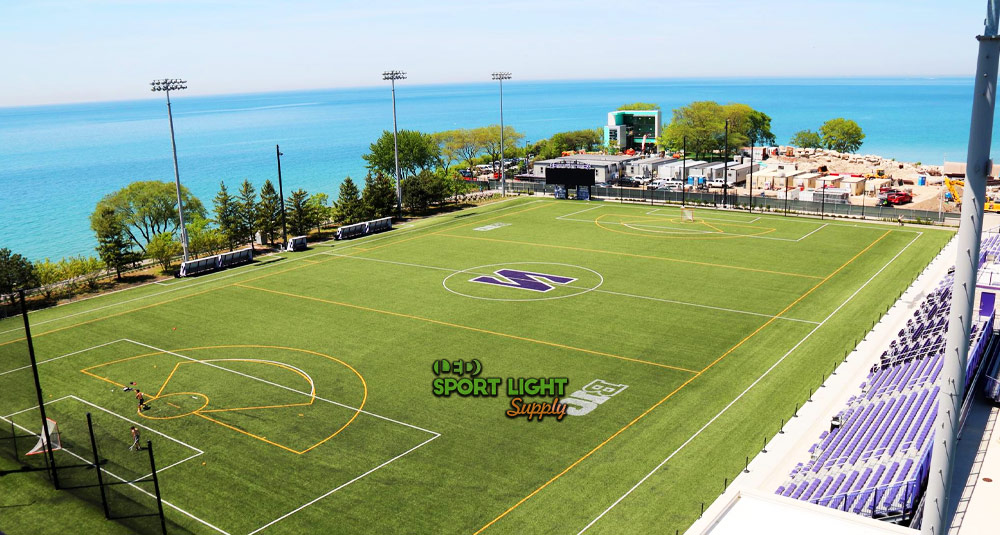
Before selecting new lights, some tests are recommendable. In fact, the first goal should be to design the soccer field lighting layout. The term layout refers to the light pole location or lighting installation arrangement. In fact, you can mount some stadium lights both on the high mast lighting pole and the corners of a ceiling.
For maximum light distribution, a lighting plan must consider many factors. First of all, the pitch size and quality of the terrain.
Hiring experts in the field to design the perfect stadium lighting layout can lead to:
- High luminous efficacy
- Energy savings
- Optimal light distribution with no or less light pollution
- Lighting systems compliant with regulations and requirements
Below are the key components of a functional football lighting layout. But you might find that not every stadium seems to follow the same rules. Over time, better tech has allowed for more efficient layouts. In reality, the same rules apply to every plan. But the varying light models and venue architectures can impact on the most suitable choice per stadium.
1. Number of soccer field light poles
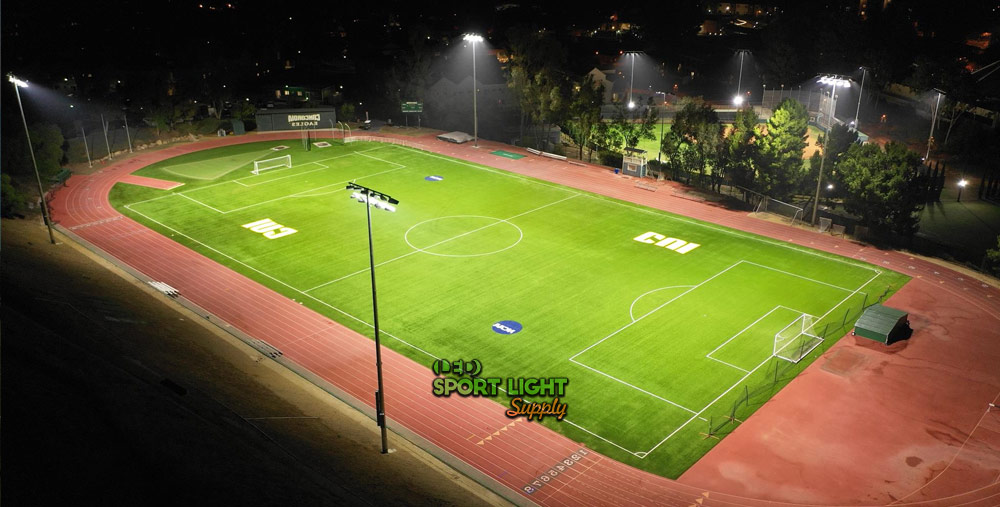
You need a minimum amount of light poles to ensure optimum lighting for both players and spectators. Also, broadcasters need a high quality of light to record and stream a soccer match. Most LED floodlight arrangments require at least four poles. In detail, the usual amounts are 4, 6, or 8, depending on the stadium circuits or level of competition.
Under the 2000 spectators mark, a sports facility should provide at least 30 horizontal footcandles on the pitch. Later, we will see what footcandles are. For the moment, just keep in mind that each sport has its own lighting requirements to ensure visibility and safety. By design, the number of light poles influences the light efficiency of the system.
The cutting and shaping of the poles follow the chosen lighting design. First, you chose the type of projector tower. Every stadium might suggest a precise light design. Next, you select the number of light poles. Finally, we proceed with the installation on site. It is important to plan each step in advance because then it is harder to move the foundation plinth.
2. Light pole height in a soccer stadium
As you can see, you find several types of playing areas, so you might be wondering how tall are soccer field lights? The minimum height of the lighting fixtures must be 15 meters tall for recreational competitions. For official competitive activity, the minimum is 18 meters.
Commonly, you can see high school athletic fields with lower light poles. Even in some football clubs, some use 8 to 20 meters tall light fixtures for training. Most light masts in high school facilities that host regional competitions range between 15 to 30 meters. On the other hand, professional stadiums must comply with official rules. Every licensed stadium must provide 30 to 60 meters tall lighting systems for FIFA matches to take place.
The right height of the light poles is critical to keep the level of glare to a minimum. Generally, too low a light fixture blinds players and spectators.
Here is a more scientific method for calculating anti-glare height. The angle between the line joining the center of the pitch and the center of the lamp holders must not be less than 25°.
3. Lighting pole position
The arrangement of the lighting depends on the level of soccer activities. Whether amateur or professional soccer, the position in the stadium creates varying effects.
Usually, the most common light pole position is at the corner or pitch perimeter. Of course, any stadium with a roof mount can exploit this feature for better lighting.
UEFA's floodlighting requirements take into account the broadcasters' needs. So, they have created a lighting guide. In it, they remind that each stadium is unique. The main goal of UEFA's lighting design is to plan the best arrangement with ten light points:
- Multiple luminaries (or light towers) at the corners near the goal lines
- At the corner's but without the focal point targeting the penalty areas
- Next to the penalty areas
- Behind the penalty areas and above a minimum distance of 30 meters (and a beam angle of more than 60 degrees)
- Further away behind the penalty areas and above a minimum distance of 30 meters (angle of more than 45 degrees)
- At the pitch perimeter, with enough lateral distance to let players move around the perimeter
- Above the pitch center line (mounted on the roof mount)
- Further away at the side of the pitch center line (mounted on high masts or roof mount) with an angle between 25 and 45 degrees
- Perpendicular luminaires to the pitchside with angles of max 70 degrees to prevent glare
- Further away at the pitchside to provide supplementary luminous flux and avoid shadows on the field
Some light positions repeat themselves to further improve vertical and horizontal illuminance.
4. Distance between the light pole and soccer field sidelines
Players and staff members must move freely along the perimeter lines of the field. Therefore, a completely free of obstacles 2.5 meters strip must go around the pitch perimeter.
This safe distance will ensure that any running player has plenty of room to decelerate. Also, it provides enough space for a stretcher in case of need.
5. Soccer stadium ceiling height
While indoor high school facilities can host one or more athletic fields with just an 8 meters ceiling height, a stadium's ceiling is way higher.
Usually, a covered stadium's ceiling is between 50 to 60 meters tall. Just so you know, the AT&T Stadium in Arlington is the highest domed stadium in the world. It has a 91 meters tall ceiling.
Commonly, the soccer stadium ceiling height varies from a minimum of 6.1 meters. In fact, that is the minimum requirement for most soccer associations.
The stadium ceiling height goes hand in hand with the overall capacity. As the stadium attracts more and more visitors, the stands need more seats. So, reconstructions and adaptations are often in place in due time.
Above the 2000 spectators mark, even the local high school soccer field would start to build a stadium. That is, to design a more functional lighting plan for better light distribution for both players and the audience.
Soccer field lighting design, standard and regulations
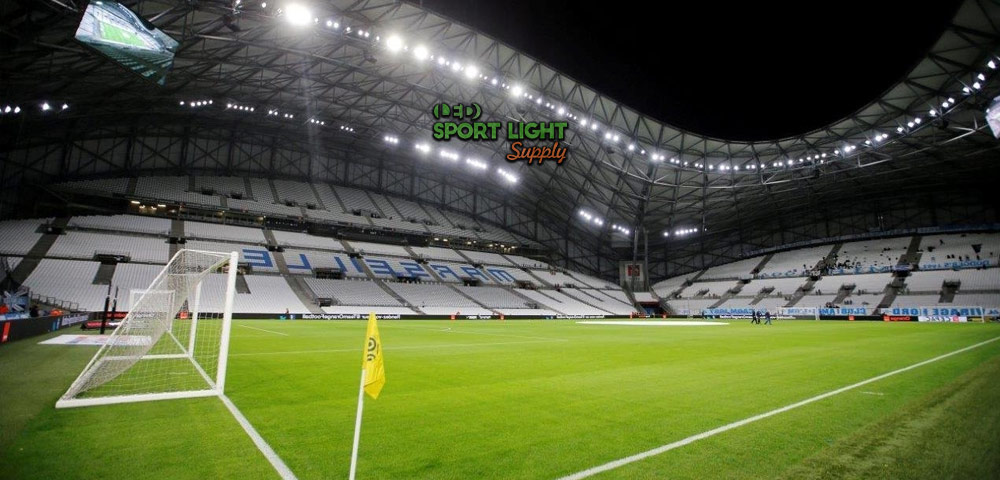
All stadiums that host official soccer matches must have artificial lighting systems. That is, enough lights for the sports competition to take place at night.
Besides, they must offer lighting for the regular running of daytime activities. Sometimes, the weather is so bad that a game may pose safety risks. It could take place, for example, in conditions of insufficient natural light.
A functional design follows a set of rules. For instance, to establish a minimum vertical illuminance value. At ground level, lighting can cause glare or light pollution.
What helps you create a functional lighting design? In short, you need to read the relative football lighting policy or regulation. This document will tell you what the limits are for your level of competition.
International standard units of measurement are in place to measure different light values. In this section, we will tackle the primary soccer field lighting standards you need to know for optimal lighting. You will learn about the IES file. Plus, what lighting uniformity is. Along with other features and best practices, such as:
• Color temperature
• Flicker-free lights
• The difference between CRI and TLCI
• Anti-glare and glare rating system
• Changing the illuminance level on the pitch
• Shadowless illumination regulations
• Maintenance and repairs
1. IES soccer field lighting lux & footcandle (brightness) levels requirement
Brightness can be a vague term. But on a soccer field, experts use precise units of measure to gauge the illuminance level.
The unit of measurement of power for a light source is the international candle (cd).
When a beam of light emitted by a candle hits a surface of one square meter at a distance of one meter, you get a lumen (lm).
But above all, a lighting designer cares for the intensity of the illumination of an object. That is, the amount of light the object receives. This unit of measurement is the lux (lx).
One lux corresponds to one lumen per square meter. Mainly in the United States, people use foot-candle (cd/ft2) instead of lux. As you can imagine, this is the illumination that a candle provides over a square foot at a distance of one foot.
You could also say that a lumen shines over a closer and smaller surface. So, the foot-candle indicates an illuminance value higher than lux. In fact, one foot-candle equal to 10,7639 lux.
When you need to control the brightness of your soccer lights, you use an IES file. In brief, this is a photometric data file. It helps the lighting designer to plan the lighting system in accordance with the governing bodies' regulation.
Thanks to light simulation software such as 3dsMax or Agi32, an engineer plans the most suitable lighting design for your arena. For the right lux or footcandle value, of course.
2. Lighting uniformity standard for a soccer stadium
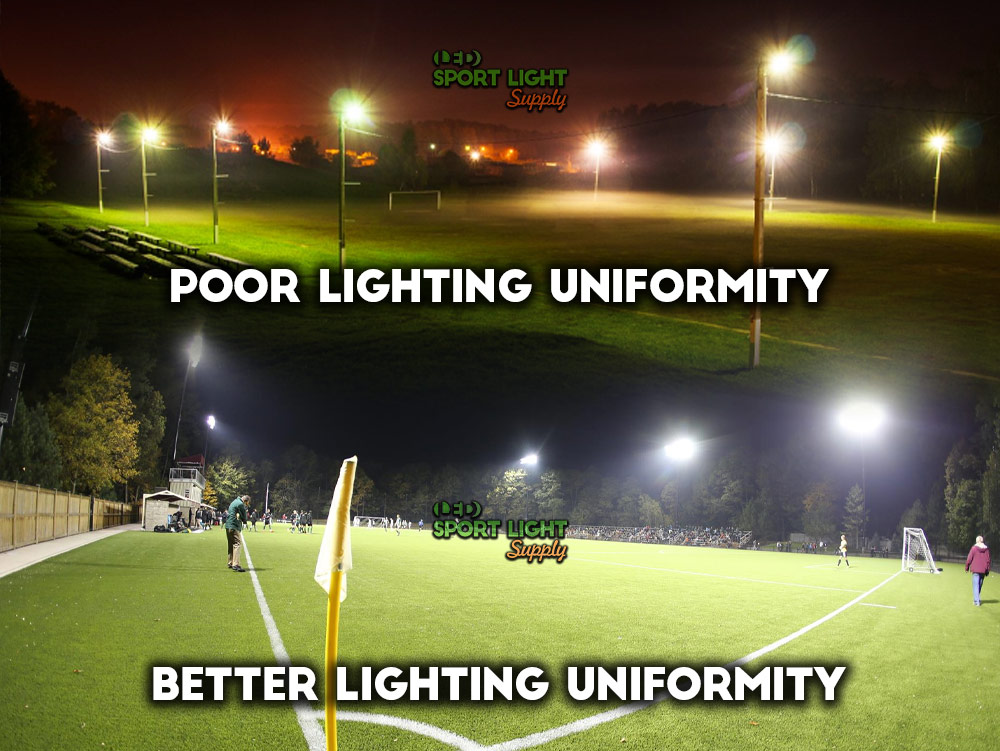
Technically, you find two terms that describe the quality of lighting. They are:
- Uniformity
- Smoothness (also known as minimum adjacent uniformity ratio)
Uniformity is the ratio between the minimum and average illuminance on the football field. This minimum level of uniformity of illumination is necessary at all times. Both in the soccer field and in the immediate surrounding area.
The overall uniformity takes into consideration the entire soccer field. Basically, you use lux and footcandle meters to measure light in several points on the field. Then, you calculate the average. The goal is to make sure that the uniformity of the standard athletic field (30 footcandles) is not over 0.65. For big soccer fields (50 footcandles) or international competitions, the limit is 0.7. Recreational use in schools and local tournaments do just fine with less than 0.5.
Anyone dealing with big sports venues should consult sports lighting designers. The professional evaluations will suggest a cost-efficient number of light poles and other details.
Smoothness refers to even light distribution. Indeed, the quality of light should not change every 3 meters (10 feet). Of course, a 10% fluctuation in the adjacent uniformity ratio of the two areas is ok.
3. Color temperature
The power of your bulbs must comply with the type of brightness you need to obtain. Today, most associations recommend the use of LED lights to cut costs and improve results.
LED lighting is available in various color temperatures. In detail, from 1700K (very warm white) up to 6500K (daylight). Also, you can choose the most suitable color temperature for each application area.
The standard field of competition design uses white light for the action. Instead, you can find a warmer color temperature back near the stands.
Often, people confuse the color temperature with the color rendering index (CRI). But, these two concepts are different. The color rendering index measures the ability of a light source to reproduce colors. Specifically, a percentage from 0 to 100 expresses the accuracy. The higher this value, the better the colors displayed by a lamp. Conversely, color temperature refers to the color of light.
The color rendering index is important when evaluating RGB flood lights.
4. Flicker-free
This term relates to LED lights that do not cause flickering. When you use a camera to record a short video anywhere a LED light is, you might notice a blur. Some lines forms to disrupt the image due to LED diodes flickering at precise wavelengths.
Of course, this issue is a big no-no for broadcasting needs. A slow-motion camera would definitely pick up the flickering and ruin the streaming of paying members. So, stadium owners must provide flicker-free LED lighting solutions when broadcasters are involved.
The flicker of light sources and, in particular, of LEDs, can cause:
- Irritation
- Distraction
- Physiological problems (such as headaches)
In any case, it causes a decrease in visual comfort, which affects the quality of performance within the illuminated environment.
To be precise, alternating current causes the flicker. LED brightness responds with very high speed to changes in the power supply. The higher the frequency, the faster the phenomenon. So, both the use of flicker-free lights or generators can solve this problem.
5. CRI and TLCI
The Television Light Consistency Index provides a better rating for professional floodlights. In short, TLCI is the camera version of CRI.
Over the years, the color rendering evaluation of a source has become a crucial topic. Given the development of LED lighting tech, today's LED lights are better.
By now, all (or almost) LED manufacturers offer advanced technological solutions on the market. Their products come with very high color rendering specifications. In sports lighting, it is normal to speak of CRI (Color Rendering Index) Ra> 90.
The color rendering index (Ra) is based on the CIE 1960 UCS (Uniform Color Space) color diagram (u, v), preferred to the previous CIE diagram of 1930.
The requirements for television and video recording changed over the years. The goal was to comply with the evolution of broadcast tech since the latest EN 12193:2018 document.
The lighting level must now adjust for HD and 4K broadcasting as well as production techniques. In other words, for video cameras, TLCI replaced the color rendering index (CRI).
In doing so, experts developed a dedicated rating system for broadcast cameras. Requirements for eliminating flicker from slow motion cameras are also included in this rating.
6. Glare
Every lighting regulation discusses the risk of glare. For this reason, specific software provides excellent support. In fact, it can determine the values of the most vital lighting parameters fast. Including glare through a glare rating (GR) system. The goal is, obviously, glare evaluation to prevent visual discomfort due to excessive brightness.
According to UEFA, an elite level A stadium must have a GR below 50. But you can find the same value for any type of stadium or competition. That is how crucial anti-glare measures are.
Both spectators and players on the soccer field should enjoy a pleasant light distribution. For safety reasons, being able to see clearly other players or emergency exits is imperative. Even the many areas surrounding the facility are at risk of glare.
The CIE publication 112:1994 states the basic criteria for a correct evaluation. But as previously mentioned, the use of a computer helps in figuring out the complex formula through specialized software. After a glare evaluation, changes in the stadium lighting system might be unavoidable to fit in with the current regulation.
7. Pitch illuminance switch mode
I bet you would like the idea of using pre-set profiles with the right lighting configurations, wouldn't you? Well, that is what the pitch illuminance switch mode (PISM) is.
Every stadium should rely on several modes. In short, they satisfy the necessary requirements in different conditions. For example, a stadium needs varying modes for when:
- The match starts
- The primary power supply fails
- The training session begins
- Repairs are in progress
The creation of a mode depends on a measurement record. First, you gauge the horizontal and vertical illuminance. You do this first step anyway to comply with the required values. Then, you need to take into account the type of event. For example, a televised match will require different settings than a non-televised one.
These lighting profiles help stadium owners to create switching modes that provide the best results. Of course, calibration is key, and multiple calibration days may be required over time.
The benefits are self-evident. In brief, you spend less time with each configuration while cutting the energy costs whenever you can.
8. Shadowless illumination regulations
If you design the correct lighting layout, no shadows will be on the soccer field. In other words, the lights should come from different directions to eliminate the shadow.
If the illuminance level cannot allow for no shadows on the pitch, then soft shadows are ok. At least for the UEFA regulation.
Positioning the light poles serves the purpose of eliminating any area of darkness. Of course, multiple light sources create more shadows. So, here is where the need for a uniformity rule comes from.
To sum up, shadows depend on the flood light positions, number, and type of light sources used. In any case, a roof mount can help to achieve the ideal shadowless illumination.
To clarify, any shape appears harsh in the presence of deep shadows. Just like those that a single narrow beam projector makes. But they can also be flat, in the absence of shadows, such as that provided by a cloudy sky. That is why mounting the light fixtures is both a science and an art.
9. Maintenance factor
Sadly, no lighting design is maintenance-proof. Several causes can make repairs inevitable. For example, soiling, bird waste, cabling problems, and the end of the LED life cycle.
The shape of the luminaires must make assembly, cleaning, and lamp change operations as easy as possible. So, it is useful to select the right mount supports from the start. For example, the front glasses should preferably be hinged to the luminous body. In this way, they would allow installers freedom of movement during maintenance operations.
In the same way, luminaires should have a simple design and clean shapes. Only these features ensure quick lamp change and cleaning times. Furthermore, they reduce maintenance costs.
Maintenance should also be periodic. Indeed, an actual maintenance programme is recommendable. A full record of any change and repair over time further helps the technicians to act promptly.
Sometimes, maintenance is the primary focus of new lighting designs. For old stadiums, energy upgrading and retrofitting are essential. They become the first steps to ensure the right voltage regulation and luminance level.
The recommended lighting Maintenance Factor value for a soccer stadium ranges between 0.85 and 0.70. That is, according to the level of competition. The higher the level, the higher the Maintenance Factor.
Soccer field lighting replacement and retrofit guide
1. Why do we need to replace or retrofit metal halide, halogen, HPS with LED lights?
LED lights are more cost-effective than old metal halide, halogen, and HPS bulbs. For many years now, we have known the problems of consumption, cost reduction, and adaptation to the territory. Any soccer field requires a large amount of electricity to run smoothly. Plus, lighting repairs are always just around the corner.
Lighting techs are constantly in the development phase. Given the low luminous efficiency of older models, LEDs are the new frontier. Plus, metal halide, halogen, and HPS lamps create a disposal problem. For example, metal halide lamps contain toxic mercury vapor.
LED flood light is not only more energy efficient, but it also has a longer lifespan. For the same power consumption, the LED lamp are better options. They generate a luminous flux approximately 5 times higher than incandescent and halogen lamps.
The high efficiency of LED tech depends on the fact that only a minimal part of the absorbed energy turns into heat. Basically, LED lamps remain cold even after many hours of operation. Instead, HPS, halogen, and metal halide lamps have an overheating issue. When they overheat, bulbs stop working. Excessive heat can also damage the lamp and casing until they break down.
2. How to replace metal halide soccer field lights
The simplest way to replace them is by choosing a power equivalent LED light. For example, we need a 300W LED to replace a 1000W metal halide. This means that the energy-saving percentage is 70%.
Mostly, an electrical engineer must understand the current lighting system first. In the lab, the engineer studies some of those metal halide soccer field lights. In this way, he or she can identify the necessary retrofit interventions.
In most cases, the specialist will need to:
- Modify the reflectors, cutting them for LED centering on new focal points.
- Assemble the lighting circuit. For example, the LED module, heat sink, fixing bracket, and power supply on the available light poles or ceiling mounts.
- Install the LED lamps and do some testing, enhancing the color contrasts if necessary.
3. How to replace halogen soccer stadium lighting
A power equivalent LED light that replaces a halogen soccer stadium light lets you save up to 50%. In this respect, the value relative to the Lumen is more relevant than the wattage. In fact, the luminous flux helps us in finding better replacements for the old halogen flood lights.
Traditional lamps have a consistent watt ratio. But with LED tech, these two values go separate ways. Also, halogen lamps have a somewhat significant decrease in watts and an increase in lumens. Both techs obtain lower consumption and better luminous efficiency. But LEDs are the best alternative at this moment.
You can either contact the sports lighting contractor or check the specs yourself. In the tech details or datasheet of the product you like, search for the lumen output. Compare the lumen (lm) value to an equivalent LED flood light to find the most suitable replacement.
4. How to retrofit HPS soccer pitch lighting
For the same power, with equivalent LED lights, energy saving goes from 50 to 80%. That is, you need fewer lamps for the same illuminance output.
For one thing, an HPS light emits yellow light. Its spectrum does not correspond to the spectral sensitivity of the human eye. In other words, the colors are not reproduced faithfully. Basically, more light is needed by default to ensure a safe vision. Usually, HPS lamps have a CRI of 20.
Instead, LED lights produce both warm and white lights with a better CRI value. By choosing any LED flood light with a power equivalent wattage, you will make a good deal. However, you will have to change the entire lighting body rather than simply replacing the lamp. So, hiring a specialist is highly recommended for safe and fast installation.
In short, HPS lamps have a series of components that allow you to ignite the gas. On the other hand, the LED diode uses an electronic circuit. You need to remove the former to install the latter.
Common mistakes when retrofitting the soccer field & stadium lighting
It is really easy to miss a step when retrofitting the soccer field and stadium lights. So, here are some reminders to help you create a checklist:
- Did you select the right equivalent lamp? Selecting the wrong power equivalent bulb is the most common problem. Choose the same wattage for metal halide and HPS lamps. But remember to compare the lumen values to replace halogen soccer lamps.
- Have you bought the right LED power supply? When the power supply does not support the new LED lights, they will not turn on. Or they will overheat, causing the lights to die or deteriorate really fast. Check the voltage of the power supply.
- Is the lighting system compatible? If the lighting control system is not compatible with the new lights, you will be able to control them. So, request maintenance service and check the signal connection.
- Did you mix flood lights and spot lights up? You need to replace each of them accordingly. Otherwise, you will incur in the wrong beam angle. Remember, flood light and spot lights are completely different things. You should also use the same angle when replacing the lights.
- Have you gone through all the necessary testing procedures? Usually, most stadium owners skip some periodic testing. But for example, the wrong color temperature, due to the gradual deterioration of LED diodes, can lower your overall score.
How to select the best soccer field lights? A buyer's guide
1. Type of lighting
First of all, the type of lights you decide to buy matters. When first browsing the shopping categories, you will find several lighting fixtures and lamps. To begin, here are the most basic types of sports lights you need to know:
- MH. Metal halide lamps belong to the large family of gas-discharge lamps. Inside the glass bulb, a quartz discharge tube hosts high-pressure mercury or sodium vapors and a mixture of metal halides. They produce a white, more bluish light.
- HPS. Sodium lamps were invented in 1920 and first produced by Philips in the Netherlands in 1932. High-pressure sodium vapor lamps came out in 1970. They make yellow, reddish light.
- Halogen lamps (tungsten halogen). In brief, they are incandescent lamps. But they differ in some features from the widespread incandescent bulbs in our homes.
- LED lights. This tech uses light-emitting diodes to convert electric current into visible light.
2. Energy efficiency
The luminous and energy efficiency of a light source is the ratio between the luminous flux and the input power. The size is expressed in lumens per watt ratio.
Usually, the definition of the luminous flux depends on the subjective perception of the average human eye. In reality, it matches a particular curve within the spectrum of visible light.
A light bulb emits radiation outside the visible band. Generally, in the infrared and ultraviolet. But these radiations do not contribute to the sensation of brightness. So, it is not just a matter of light conversion.
A lamp has a higher luminous efficiency when it can emit a spectrum suitable for human perception. When it does so at a lower cost than power equivalent lamps, the tech is cost-effective. For soccer stadium lights, the most cost-effective techs are, in ascending order:
- HPS (the least cost-effective)
- MH
- Halogen
- LED (the best cost-effective)
3. Soccer field lighting wattage
Because of the great distances in a stadium, football lighting systems use powerful lights. For LED lights, the common wattage is 1000, 1500, 2000 watt.
In comparison, for the same power, MH, HPS, and halogen lamps produce fewer lumens. You can see the details in the corresponding datasheets.
When choosing these types of lamps, you need to compare the overall wattage with the relevant protection. That is, the IP enclosure ratings.
When you buy high-performance flood lights, you must know that the casing is waterproof and dust resistant. The IP 65, which offers both protections, is one of the most popular for soccer stadium lights.
4. Life span
Perhaps, not everyone knows the average life of a light bulb varies a lot. The most influential factors are usage and aging. But all sorts of issues can arise to shorten the estimated life span of a soccer light.
You can expect your athletic field lamps to last for many hours. In detail:
- Halogen bulbs have the shortest life span, averaging 2,000 hours tops
- Metal halide can provide enough lighting for about 6,000 hours
- HPS usually lasts between 6,000 and 8,000 hours
- LED has a life span up to 150,000 hours
If the lighting on your pitch suffers from burned bulbs, then you need to rule out possible causes. Typical issues include:
- Overheating. Too much heat causes your soccer field light to die faster
- Old lamp holder, which causes thermal shocks and arcing
- Old or faulty ignition switch that causes arcing when turned on/off
- Cheap, poor quality bulbs
5. Color temperature
The color temperature of light (hue) uses the CCT (Correlated Color Temperature) index. On the product label or datasheet, you can find this value in degrees Kelvin (K).
The Kelvin degrees tell you what the light of the bulb you are about to buy will look like. Bulbs that tend towards yellow produce a warmer hue. On the other end of the spectrum, you find those that tend to make more blue, cold light.
The best color temperature for official soccer events is the 5,000-6,200K range. For example, UEFA will not allow a color temperature below the 4,200K minimum.
One of the perks of LED lighting systems is the possibility to change the color temperature. Thanks to this feature, artificial lighting can adjust to the natural variation during matches in the late afternoon.
6. Beam angle
The luminaries' beam angle varies to provide a comfortable vision to both players and spectators. The main difference lies in the type of device. To sum it up, here is a flood light vs spot light recap concerning the best practices:
- The flood lights' beam angle between the line joining the center of the field with the frame of the supports must be more than 25° and less than 45°.
- The spot lights' tilt at 90° can allow for a 30° beam angle. That is, a ceiling-mounted spot light perpendicular to the pitch with a beam angle of 30 degrees. But, it is imperative that on the ground level, the beam angle is below 60° to prevent glare.
If you set your flood lights' beams perpendicularly to the pitch, do not exceed 70°. Usually, flood lights are available with a minimum beam angle range of 30-150 degrees. LED downlights range between 30-60. Instead, LED spot lights offer 15-90 degrees. In other words, you can find plenty of options for your stadium.
7. Anti-glare feature
Anti Glare lighting relies on specific filters to diffuse the light before it reaches your eyes. In detail, a micro prismatic anti-glare diffuser ensures softer light. A reflector system lets you control the light uniformity and anti-glare effect at the same time. Not every lamp or bulb has this feature. But the ones with it show a badge on the label. Or it says so in the tech details.
The anti-glare feature reduces eye strain and discomfort glare. Glare causes the retina to significantly lower its sensitivity. In these conditions, it is no longer possible to see anything around you. In other words, this issue can lead to injuries or security risks.
Without this feature, the artificial lighting can hinder anyone in the surrounding areas of the stadium. During high school, you might have seen them in classrooms for the visually impaired. Rarely, you will find them in the athletic field or practice pitch. But you will always find this tech in important soccer venues.
8. Lighting for Mobile light tower or conventional light pole?
On a training pitch, the lighting layout could be insufficient. Think high school athletic field with only a standard flood light. In these cases, mobile light towers come in handy.
How do you know if you need a movable light tower or a conventional high mast? Basically, you think in terms of safety measures and competition level. When the standard lighting system provides inadequate illuminance, use mobile light towers. These temporary solutions help you to cope with maintenance and repairs as well.
Mostly, mobile LED light towers are available in two variants. To specify, the ones with a trailer for more demanding soccer fields. And the one without a trailer, and often, without a generator.
The conventional light pole is the best option for primary soccer fields. You need a high mast anywhere you set an official sports event for the bests results. Mobile LED flood lights are meant to be used as a support.
9. Lighting control system
Different light effects or play of lights require specific control systems. For one thing, make sure that your power supply is DMX or DALI compatible.
DMX and DALI refer to lighting control systems. Traditionally, lighting fixtures are simply adjusted by switching them on and off. Usually, this regulation mode (ON/OFF) takes place with a click on a switch. But the new fixtures also allow for the adjustment of light intensity (dimming). Or the color selection through analog and digital techs. This is true for most high-efficiency lights. Especially for LED light sources.
The Digital Multiplex (DMX) protocol is suitable to control RGB lights. Overall, it is the fastest and better protocol for this task.
The Digital Addressable Lighting Interface (DALI) protocol is another reliable lighting control system. In short, it manages the interface and the rules of:
- The electronic ballasts
- The brightness
- Presence sensors (peripheral units)
- The control unit (also known as the command module)
10. Weight of lighting fixtures
Here is an underrated topic concerning the various types of lights on the market: their weight. If the lights are too heavy, you may need to reinforce the light pole.
Excessive weight could hinder the light pole wind resistance. In fact, the latter depends on the weight of the light pole, the light fixtures, and accessories. For more info on the relevant factors, check out the UNI EN 40-6:2004 document.
Light poles can only function as support for the flood lights. They are subjected to a specific design in accordance with current standards to support certain lighting fixtures and nothing else. So, in case of any doubt, ask your light pole contractor. Alternatively, you can hire an engineer to calculate the wind pressure on your light poles.
11. Installation accessories
The installation phase is the most exciting one. But in order to get it right, you might need some installation accessories. For example, laser pointers and brackets. Sometimes, before installing a floodlight, we may attach the laser pointer on the lights, so we can know where does the light point.
Laser pointers are a tool that let you determine the light beam accurately. A professional light meter is another useful accessory to do more testing. Plus, you can use it regularly to measure light deterioration.
Do not forget that many birds are dangerous threats to your light fixtures. Stainless bird spikes are necessary for an outdoor soccer field in an urban area. Even in remote areas, some birds might nest on LED light fixtures as they provide a welcoming warmth.
12. Warranty
Even when you install a LED spot light properly, manufacturing defects can always show up. So, when you buy any lamp, evaluate the product warranty.
Sometimes, an alluring price may cloud your judgment. Of course, you would prefer it to last for many years. At the very least, you hope to be able to amortize the costs you had to incur. But you cannot be 100% sure. So, you need a good warranty on the product. And not only that.
When you purchase a new light fixture for your stadium, ask what you need to do to contact the customer care. Set that information and relevant documents aside. You can never know when you might need them.
Do not calculate your ROI without considering how many years of warranty the product gives you.
Average soccer field light cost
1. The cost of buying the soccer field lights
You might be eager and prepared to make the investment. So, how much would it cost you to buy enough soccer field lights? Here is what you can expect to invest:
- For training: $10,000 to $50,000
- High school: $50,000 to $150,000
- Professional: $150,000 to $500,000
These estimates take into account the necessary flood lights and spot lights to reach optimal pitch illuminance.
Often, choosing LED lights may lead to higher prices. But that is not bad news. In fact, you should consider the maintenance costs. Here, in this example, you look at the total cost for the whole soccer field lights package.
The previous info about the light features will guide you to select the most suitable products for your stadium. Above all, the main goal is to get the most cost-efficient football lights for your needs and goals.
2. The cost of installing the stadium lights
Installing the lights can cost you more than the luminaries themselves. If you do not get a good deal, you can expect to pay up to $250,000.
In reality, many factors influence the total cost of installation of the light fixtures. For example, the number and type of luminaries, plus the accessories, machinery, and labor.
The usual quote ranges between $70,000 and $250,000 for a premier league football stadium. Also, the size of the pitch and the general conditions of the area can influence the total price.
Electrical servicing upgrades can greatly vary. For example, changing an electrical panel can cost around $500 – $1,900. Instead, retrofitting a professional stadium can cost you $350,000 and up, depending on what you need to upgrade.
Related sports lighting article: Soccer field lights for sale
Soccer pitch lighting Q&A
1. What wattage are stadium lights?
The necessary stadium light wattage ranges between 30,000 to 250,000 Watt. Of course, the number of light fixtures, spot lights, plus the type of luminaries can influence the wattage.
Just so you know, a World Cup arena consumes approx. 25.000 kWh per match. If you consider the standard family of four's electric bills, a stadium eats up nine families' yearly energy consumption in an evening.
The lighting of sports facilities is bound by specific needs, which are impossible to ignore. Above all, if not accurately designed, the lighting of sports facilities can create problems. For example, LED lights can become a significant source of light pollution.
Sometimes, the rules leave little room for changes in the projects that can lead to a lower level of light pollution. And this also means that the minimum wattage cannot further decrease.
2. What are stadium lights called?
Football stadium lights have many names. Generally speaking, people call them:
- Floodlights or flood lights
- Spotlights or spot lights
- Downlights
Floodlights create a wide beam of light. Think street lighting systems. In a stadium, the light pole supports a larger frame than usual. In fact, the light holder contains more lights to provide the necessary lux or footcandle values.
Spotlights create a narrow beam of light. Think actors on the stage in a theater during a monologue. A spot light provides extra illumination for important areas on the soccer field. For example, the penalty area.
Downlights create a custom beam of light. Mostly, in a stadium, you find them at the entrance or emergency exits. You can choose the beam angle you prefer and hide them in walls.
3. How to turn on soccer field lights?
In high school facilities, you might have to access the electrical box. In fact, old stadium lighting systems may still rely on the inner control panel. A light code might be necessary for more advanced systems. Without this code, it is impossible to turn the lights on and off.
Most sports facilities use a centralized console for light control. The DMX protocol (Digital multiplex) is the most used digital system for the management of lights for entertainment and sporting events.
The lighting system is controlled by a central console that allows you to set different lighting scenarios. Plus, create spectacular plays of light if you have RGB lights. This system adds excitement to the soccer match during the breaks. Also, it is increasingly popular in the lighting of high-level stadiums.
4. Why do stadium lights take long to turn on (for metal halide)?
Metal halide lamps can take up to eight minutes to reach their max brightness level. On average, you need to wait five minutes for most models.
Turning metal halide lamps off and then on again will add ten more minutes. Due to the complex devices that regulate ignition, there is nothing you can do but wait.
When the lamp is cold, metal halides are deposited on the walls of the lamp. As the temperature of the arc increases, they vaporize. Then, they spread in the inner tube away from the walls. Only then do they dissociate into free atoms of metal and iodine, creating visible light.
In detail, the ignition of current metal halide lamps (without auxiliary electrode) is obtained with a pulse igniter. This piece ignites a breakdown voltage of the order of a few kV. Sadly, this reaction takes time.
5. How much does it cost to put lights on a soccer field?
The total cost could include more than the luminaries and the installation service. For example, updating the power lines might be necessary before proceeding with a precise soccer lighting layout. The same goes for other issues like soil stability, for which you might need to hire a geotechnical engineer.
More or less, you can expect to pay around $70,000 – $100,000 for a high school soccer field. Instead, the number goes up for big stadiums that need many specialists and professional testing procedures. Up to $800,000 and more. Renovations and upgrades can also lead to a similar project budget.
I suggest you read the previous part on the average soccer field light cost for more details.
6. Symmetric vs asymmetrical soccer stadium lighting – what are they?
Symmetrical lights produce an even light distribution. Sadly, they cause eye strain and glare. They are the least recommendable lights for soccer stadium lighting.
Asymmetrical lights have a different design. They allow you to get the most out of the stadium lighting layout thanks to asymmetrical light distribution. In short, they produce a wider beam angle than symmetrical lights.
To be precise, symmetrical floodlights are rarely installed with the intended screens. These screens limit the dispersion of light outside the area to be illuminated.
Today, asymmetrical flood lights are more wide-spread. The light intensity distribution allows you to point most of the luminous flux in a precise area. Plus, they let you install systems with a higher utilization coefficient than standard flood lights. That is, you can mount more cost-efficient and powerful LED lights. So, you save money and electricity while upgrading the lighting system.
7. Where was the first floodlit soccer match played?
The first floodlit Football League match ever played took place in Fratton Park, Portsmouth, on 22 February 1956. A problem with the floodlight system almost ruined the game before it started. But the electricians on-site managed to fix the issue in time. For the record, Newcastle United won 2-0 against Portsmouth.
The first experiments with floodlighting were held in Sheffield, UK. Experimental matches in 1878 were held to test the new tech, but the Football League refused to use them. The first, floodlit friendly tournament took place in Southampton FC's stadium on 31 October 1950.
Today, most stadiums use LED lighting systems. We can also admire different architectural peculiarities. Today's devices and lights allow for impressive lighting projects.
Conclusion
This ultimate guide on soccer field lighting has covered the basics and some technical aspects. Whatever the pitch, this info applies to both stadiums and high school soccer fields alike.
For the best results, be sure to download the regulation of the football association that you are part of. You can now follow through and design a LED lighting layout yourself or hire some experts. Above all, make sure to do plenty of testing to reach the most critical values, as discussed.
If your goal is an official lighting standard, you will need to comply with all the requirements we listed here. So, take your time to read our sections on retrofitting and buying new lights. They will help you to make the best choice.
Source: https://sportlightsupply.com/soccer-field-lighting/
